#COVID-19 and Breastfeeding in Combat Boots
by Mom2Mom Global
Everything servicemembers need to know about breastfeeding during the COVID-19 pandemic.
As we all adjust to the necessary changes in order to contain and mitigate the global pandemic, many military servicemembers are mobilizing to respond to this threat. If you are Breastfeeding in Combat Boots, we want to make sure that you have all the resources available to you to continue to make informed decisions best for your health, your baby, your family, and your mission. This is the third installation in our 3-part series on COVID-19, a joint collaboration with veteran and Army spouse Shondra Mattos, IBCLC from Mattos Lactation. Be sure to read our first post on breastfeeding and our second post on pregnancy and birth for more information. We will update all three posts as more information is released in response to this rapidly evolving situation.
Mobilizations and Deployments
Possibly never before in our lifetime have we faced a phenomenon requiring such a coordinated global response as this. Coronavirus is rapidly spreading and as it does, new data is constantly being gathered, analyzed, and synthesized to update recommendations and treatment protocols. Across all 5 Service Branches and the Public Health Service, military medicine is taking the lead in responding to this pandemic. At the time of this writing (April 8, 2020), thousands of military medical personnel are deployed to New York City, Los Angeles, New Orleans, Dallas, and other cities; and thousands of Active Duty, National Guard, and Reserve servicemembers have been put on notice to prepare for mobilization. If you are currently a lactating servicemember, chances are you're already impacted by COVID-19.
Important points for ALL servicemembers to know: ->COVID-19 does not appear to transfer through breastmilk. ->Human milk provides active immune properties that may protect your nursing child from any potential exposure before symptoms develop. ->The WHO, CDC , UNICEF, ACOG, AAP, and ABM all suggest the continuation of breastfeeding for COVID-19 positive parents and encourage the proper precautions to be taken to reduce the potential spread.
If you are NON-ESSENTIAL and/or teleworking from quarters:
Follow all local command and civilian authority instructions on social distancing, remaining in quarters, and using precautions such as frequent handwashing/sanitizing and masks.
Increase your pumping frequency to build up a stash of expressed milk that can be used in your absence. Try these great strategies from Mattos Lactation for increasing pumped output.
Stay in contact with your supervisor/command team and ensure that they know that you are a lactating parent and will require biological breaks to eat, stay hydrated, and express your milk while on shift in order to maintain your health and continue to be able to carry out your mission. If you are deployed to a medical response mission, this will likely require extra time to remove PPE.
If you decide to wean before or during a deployment or mobilization, consult a skilled lactation supporter to determine a weaning plan that best suits your individual circumstances.
Enjoy your time with your family, and take time to prepare your little ones for the possibility that you may have to leave.
If you are ESSENTIAL and currently working in support of the COVID-19 response at your home duty station:
Check out our HAZMAT info sheet for tips about minimizing exposure risks
Follow all local command and civilian authority instructions on social distancing, remaining in quarters, and using precautions such as frequent handwashing/sanitizing and masks.
Continue to communicate with your supervisor/command team to ensure that you are given biological breaks to eat, stay hydrated, and express your milk while on shift in order to maintain your health and be able to carry out the mission. If you are required to wear PPE on duty, your break time will need to accommodate extra time to remove your PPE.
Be aware that mastitis symptoms can be similar to COVID-19: fever, body aches, fatigue, flulike symptoms. Mastitis is commonly caused by milk stasis, or not removing milk frequently enough, so it is mission essential to make time for pump breaks.
Depending on your level of exposure, based on your specific duties, you may want to consider infection prevention controls (IPC) at home:
->Changing clothes and shoes and/or showering before you leave work
->Removing all shoes and clothing before entering your home, or immediately upon entering
->Washing or sanitizing hands immediately upon entering your home, before touching anyone or anything
->Showering and putting any clothing worn on duty immediately into the wash
If you decide to wean before or during a deployment or mobilization, consult a skilled lactation supporter to determine a weaning plan that best suits your individual circumstances.
If you are MOBILIZED or DEPLOYED in response to COVID-19, check out our info sheet on Pumping in the Field, and
Follow command orders and work with your supervisor to mitigate exposure risks, based on what you are issued and what your duties are. PPE for healthcare providers, masks and gloves for logistical support personnel, etc. Practice social distancing at your workspace and quarters, maintaining a distance of at least 6 feet from others as much as possible.
Continue to communicate with your supervisor/command team to ensure that you are given biological breaks to eat, stay hydrated, and express your milk while on shift in order to maintain your health and be able to carry out the mission. If you are required to wear PPE on duty, your break time will need to accommodate extra time to remove your PPE.
Be aware that mastitis symptoms can be similar to COVID-19: fever, body aches, fatigue, flulike symptoms. Mastitis is commonly caused by milk stasis, or not removing milk frequently enough, so it is mission essential to make time for pump breaks.
Work with your supervisor/command team to find adequate space for pumping. Ideally, lactation space should provide a private space with a locking door, a sink, a flat surface that can be wiped down with sanitizing wipes before and after each use, electrical outlet. If you must pump in a vehicle or non-enclosed space, use prepackaged sanitizer wipes and ask anyone within 6 feet of you to wear a mask while you pump. No matter where you pump:
->Wear a mask and wash or sanitize hands with alcohol-based sanitizer. If available, consider using disposable gloves while pumping.
->Consider investing in a wearable pump.
->Wipe down all surfaces, pump, and pump parts with sanitizer wipes before and after use.
->Consider having several "pump packs"-sets of flanges, tubing, etc, with each set in an individually sealed plastic bag for single use, then wash & sterilize all parts at home.
->Wipe down outside of sealed milk storage containers with sanitizing wipes, then store in your cooler.
->Wash hands and consider using disposable gloves to move milk from the cooler to a personal refrigerator or freezer in your quarters.
TB Med Waiver 530 is in effect for the Army and allows human milk to be stored in DFAC refrigerators. The Navy is working on a similar waiver. We will update as more information becomes available.
See our info sheets on Traveling with Milk and Shipping Milk if you're bringing your milk back to your child.
If you are not able to transport milk back to your child, consider donating your milk locally. Human milk banks are continuing to accept donor milk, and experiencing shortages due to COVID-19. Peer to peer milksharing may also be considered, as discussed in our first post on breastfeeding and COVID-19.
If you get sick with COVID-19, keep pumping. The milk is safe to give your child!
If you decide to wean before or during a deployment or mobilization, consult a skilled lactation supporter to determine a weaning plan that best suits your individual circumstances.
Infant and Young Child Feeding in Emergencies
All major health organizations agree that breastfeeding is the safest way to feed infants and young children during any emergency, and there are no reported cases of transmission of COVID-19 through breastmilk, therefore it is safe and advisable to support breastfeeding initiation, duration, and relactation during the COVID-19 outbreak.
The DoD COVID-19 Practice Management Guide recommends supporting breastfeeding in MTFs in the following ways for patients who test positive or are PUI:
Teach parents appropriate hand hygiene before and after breastfeeding or pumping.
Parents will wear a mask while expressing milk or feeding at breast.
Provide each lactating parent with a designated pump to express milk
Wipe down all surfaces, pump parts, and milk storage containers with sanitizing wipes before and after pumping.
The decision to co-locate or separate postpartum parent and neonate is the parent's decision, to be made after informed discussion with the healthcare team.
MTF healthcare staff should follow appropriate PPE and IPC protocols based on the policies of their local facilities and commands.
Other considerations:
Human milk contains antibodies to infections, before onset of symptoms.
By the time a lactating parent tests positive for COVID-19, their nursing child has already been exposed to the virus, therefore continuing breastfeeding poses no additional risk of transmission.
Breastfeeding provides mental health benefits to parent and child during times of stress.
Human milk is the optimal nutrition for infants and young children.
Formula shortages may occur if transportation restrictions disrupt normal delivery schedules.
Appropriate respiratory hygiene, hand washing, and cleaning and disinfecting of surfaces and feeding supplies is recommended for infant care and feeding for ALL infant caregivers who have symptoms of, are under investigation for, or have confirmed COVID-19 regardless of infant feeding method.
Families should be counseled on social distancing for the infant at home, and encouraged to limit or prohibit visitors to the household for at least the first 2 weeks of life to minimize the risks of exposure from visitors.
Resources
U.S. Breastfeeding Committee Infant and Young Child Feeding in Emergencies COVID-19 Update
DoD COVID-19 Practice Management Guide
Carolina Global Breastfeeding Institute COVID-19 Resources
Operational Guidance for Infants and Young Feeding In Emergencies
UNICEF Infant and Young Child Feeding in the Context of COVID-19 brief
Contributing authors for this blog post are Shondra Mattos, IBCLC and Amy Barron Smolinski, MA, ALC, CLC.






